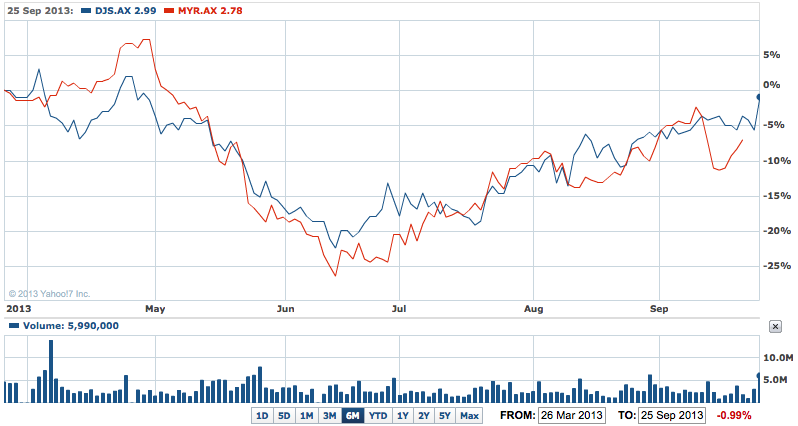Given the 1% to 2% slide in topline and same store sales in its 2012-13 financial year, a weaker result from David Jones (DJS) was always expected by the market.
But contrary to the negative reception from investors that bigger competitor Myer (MYR) received almost two weeks ago with its small profit fall result, David Jones shares positively surged, rising nearly 5% yesterday.
In fact the shares hit a day’s high of $3.06 and ended at $2.99 in an unexpected show of strength – granted this was in a market which jumped by almost 1% after two days of falls.
DJS vs MYR 6-Month – Unlike Myer, David Jones’ 2012-13 result triggers a price surge

In a statement and comments at a briefing from CEO Paul Zahara, the message was the now familiar mantra of how the company continued to face tough retail conditions due to weak consumer sentiment and aggressive discounting by rivals.
Of course all retailers faced those conditions in 2012-13, and we have seen not everyone was crunched like David Jones and Myer were – Kathmandu was the latest of the small groups of retailers to report a strong rise in sales and earnings for the same year as Myer and DJ’s endured.
And yet, David Jones’ underlying profit was better than many had expected at $101.6 million, almost unchanged from $101.1 million last year. Of course that’s down from the $170 million earned in 2010. David Jones’s performance in the past three years has been pathetic.
Total sales for the 2013 financial year were down 1.2% to $1.85 billion, while like for like sales (same store) were down 1.8%, which was announced earlier this month and perhaps saw quite a few investors project a rotten result for the struggling department store chain.
But despite the negativity, dividend was set at 17c for the full year, down only half a cent from the 2011-12 level. The final for the latest year was an unchanged 7c a share.
CEO Zahra said DJ’s expected trading conditions to remain challenging during the next 12 months, but said the department store business was well placed to benefit from any future improvement in consumer sentiment.
He said the retailer would focus on keeping costs down and improving margins while it waited for consumer sentiment to pick up.
‘‘In this environment we are focusing on managing those parts of our business that we can control such as inventory, gross profit margins and costs,’’ he said.
‘‘As a result of this work we are well positioned to fully leverage any improvement in consumer sentiment as and when it occurs.’’ He did mention that there had been a slight uptick in retail traffic since the election on September 7.
David Jones reported a 6.6% fall in net profit for the year to July 27 of $95.2 million, against the $101.1 million earned in 2011-12.
The net figure however includes a $9.1 million pre-tax charge relating to the company’s move to hand over control of its electronics business to retailer Dick Smith, so the net result would have been closer to $105 million, which cheered investors.
But there were a couple of other interesting points that investors focused on: online sales are now "roughly" 1% of sales, or around $18 million.
That’s baby steps, but any positive news on online sales is good news these days. The retailer also said it is trying to do deals with suppliers to match their offshore prices in David Jones stores.
And Mr Zahara suggested the retailer was looking at monetising the air rights over its Market Street store in Sydney’s CBD, which opens up property and retail development rights. There are already a number of residential apartment blocks in and around the area, such as at Westfield’s big Sydney City centre and along Elizabeth Street, close to Market Street.
The upper levels of the building would have expansive city and harbour views. Now, broking analysts will look for other stores in the company’s chain where air rights and development might be possible. Most though are in shopping malls in leasehold locations which mean no such deals are possible.
And, finally, like Myer the nitty gritty of the David Jones result shows signs of a company better placed than the market sees it.
For example the gross margin rode 80 points to 23.3%, even though there was a 110 point rise in the cost of doing business (to 32.9%) thanks to higher wage, utility and investment costs (in a new point of sale system). Second half margin growth slowed, but all retailers took a pounding in the second half of 2012-13, only some rode it out better than David Jones and Myer did.













